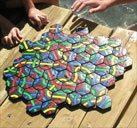|
|
 |
|
| TANTRIX GAME RULES |
|
Opponents and colours Conventional games of strategy like chess are based on pure skill and the outcome between players of different ability is not in doubt. In Tantrix, there is both skill and an element of chance. The best player usually wins, but not always! While three or four player games are often more fun socially, the two-player version is more skillful and preferred by tournament and master players. Before you start, each player must choose a colour: red, yellow, green or blue.  Objective of the game The aim of the game is to make the longest line (or even better, a loop) of your chosen colour. To begin, all 56 tiles are placed in the bag and each player takes a tile at random. Whoever has the highest number starts. Each player picks up five additional tiles at random so that they have a ‘hand’ of six tiles. The tiles are placed face up on the table in front of each player and must be visible to the other players. The opening move The first player places any tile from their hand into the middle, then picks up a replacement tile from the bag. Play continues in a clockwise direction, i.e. the next player connects a tile to the first tile and so on. Always have six tiles in front of you! So pick up a replacement tile every time you play a tile, whether your move is free or forced. There are no exceptions. A forced space is any empty space bounded by three tiles. Forced spaces always have to be filled if possible! |
||
|
When it's your turn With the possibility of forced spaces, each player’s turn becomes a three-step process of:
What is a forced space? Any empty space which is surrounded by three tiles is called a forced space (they are indicated by a coloured dot). Each player must start their turn by filling forced spaces whenever possible. A little arrow next to a tile tells you this tile fits into a forced space! Forced spaces become more common as the game progresses and allow a player to play a number of tiles in one turn. It is a normal procedure to create forced spaces deliberately, especially when you're forcing yourself to fill the just-built space.  |
||
|
Step 1: Filling Forced Spaces Start your turn by looking for any forced spaces left unfilled by the previous player. Then check if you have tiles that fit any of these forced spaces, filling them if you can. Remember to pick up a replacement tile each time you play. Forced spaces become more common as the game progresses and filling one forced space often creates another, which you must also fill if possible. Step 2: Make Your Free Move After filling all the forced spaces you can, it is time for your free move. You only have one free move per turn, so choose wisely. You can select any one of your six tiles and play it anywhere provided you obey the three restrictions and that all colours must match. It is common practice to place your tiles close to the ‘Tantrix’ (i.e. the tiles already played) when testing moves. However, once a tile has touched the Tantrix it may not be moved. Do not forget to pick up a replacement tile, so you always have a hand of six. Step 3: Filling Forced Spaces Before your turn is over, you must again check your tiles against all forced spaces. If you can fill any, you must! And pick up a replacement each time you play a tile. |
||
|
The Three Restriction rules Players must obey the following three restrictions as long as there are tiles left in the bag. Once the last tile has been drawn, all three restrictions are lifted immediately.
|
||||||||
|
The Endgame
When the bag is empty (no tiles left), the three restriction rules are lifted. This period of play is called the endgame. You must still follow the forced space and golden rules, but you can now create spaces with three links of the same colour and four-sided spaces and play along controlled sides. An example: In this game (see diagram), the Green and Blue player are currently tied. Green has a line of eight, while Blue has a loop of four, both players scoring eight points. However, Green is in a much better position to win the game from here, as an unblocked line can be extended, whereas a loop is closed forever. Blue's loop of eight points won't be enough to win the game - the average winning score in a game is around 23. Blue would be well advised to start working on a new line, as well paying attention to the loop threat Green developed. With only one more tile, Green could close a loop of 11 tiles, scoring 22 points - most likely, enough to win this game. You'll need a combination of careful analysis and devious tactics to win. There is also a bit of luck involved, since everyone draws their tiles at random from the set. This combination of skill and luck makes Tantrix fun for both new and experienced players. Enjoy playing ! |
||
| Home | Site Map | Products | Play Online | Buy Tantrix | About Us | Contact Us |
© Copyright 2017, Colour of Strategy Ltd, Pohara, New Zealand. All rights reserved. Last update: July, 2017 |



